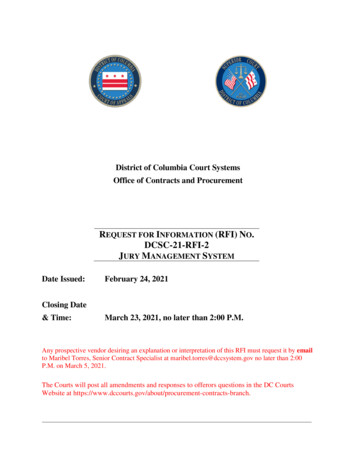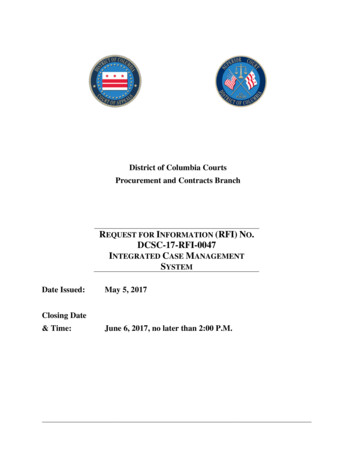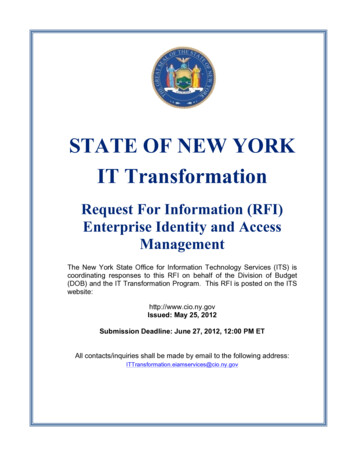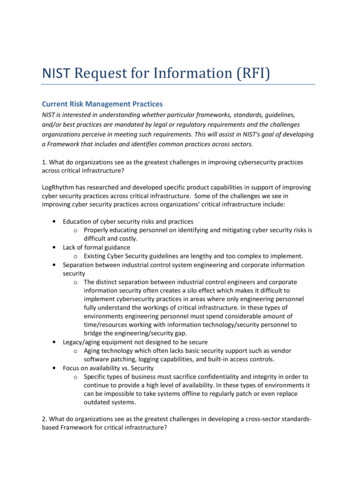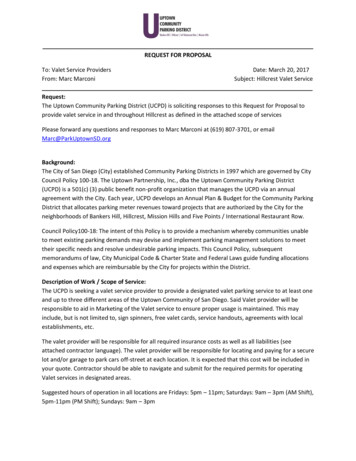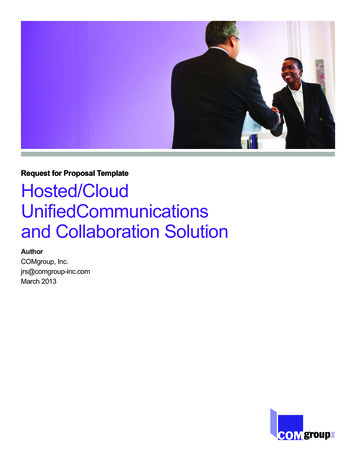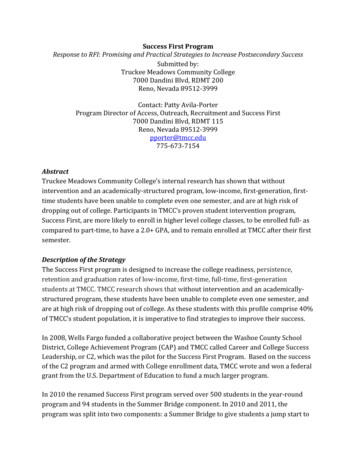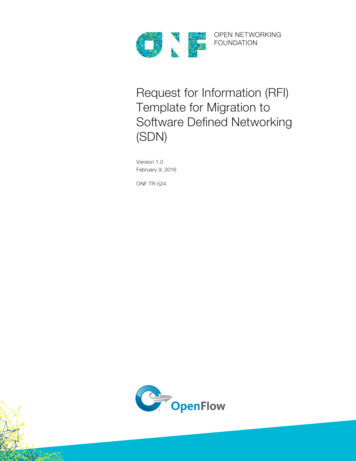
Transcription
Request for Information (RFI)Template for Migration toSoftware Defined Networking(SDN)Version 1.0February 9, 2016ONF TR-524
Request for Information (RFI) Template for Migration to Software Defined Networking (SDN)ONF Document Type: Technical RecommendationONF Document Name: Request for Information (RFI) Template for Migration to Software Defined Networking (SDN)DisclaimerTHIS SPECIFICATION IS PROVIDED “AS IS” WITH NO WARRANTIESWHATSOEVER, INCLUDING ANY WARRANTY OF MERCHANTABILITY,NONINFRINGEMENT, FITNESS FOR ANY PARTICULAR PURPOSE, ORANY WARRANTY OTHERWISE ARISING OUT OF ANY PROPOSAL,SPECIFICATION OR SAMPLE.Any marks and brands contained herein are the property of their respective owners.Open Networking Foundation2275 E. Bayshore Road, Suite 103, Palo Alto, CA 94303www.opennetworking.org 2016 Open Networking Foundation. All rights reserved.Open Networking Foundation, the ONF symbol, and OpenFlow are registered trademarks of theOpen Networking Foundation, in the United States and/or in other countries. All other brands,products, or service names are or may be trademarks or service marks of, and are used to identify,products or services of their respective owners.Page 2 of 24 2016 Open Networking Foundation
Request for Information (RFI) Template for Migration to Software Defined Networking (SDN)Table of Contents1. Introduction . 41.1 RFI Template Development Objective . 41.2 Intended Audience and Updates . 41.3 Terminology . 52. Architecture for SDN Migration . 73. Operator Type and Identity Information . 94. Considerations for Gathering Information . 114.1 General Migration Requirements . 114.2 SDN Migration Solution Requirements . 134.3 SDN Migration Device and Function Requirements . 134.3.1 Common Set of Requirements . 134.3.2 Industry/Service Specific Requirements . 165. Conclusions . 186. Acknowledgements . 197. Revision History . 198. References . 20Appendix A: SDN Migration Prototyping Results . 21Contributors . 24Page 3 of 24 2016 Open Networking Foundation
Request for Information (RFI) Template for Migration to Software Defined Networking (SDN)1 1. Introduction1.1RFI Template Development ObjectiveA request for information (RFI) is a standard business process whose purpose is to collectwritten information about the capabilities of various suppliers, vendors, or providers. Normally itfollows a format that can be used for comparative purposes, and is usually a preliminary activityin an acquisition or deployment process. The objective of this document is to offer a genericRequest for Information (RFI) template for the Operators and Service Providers who are at theearly stage of use case [1] based migration from a traditional network to a Software DefinedNetwork (SDN [2, 3]).This document also attempts to describe the challenges that the network operators must addressfor migration from a traditional network to an SDN based architecture. The migrated networkmay contain both traditional and SDN based networking elements in order to facilitate multiphase migration to full SDN based system.1.2Intended Audience and UpdatesThis RFI template is intended to serve as a guideline for network services operators who areconsidering gathering information on migrating to SDN based network architectures, inparticular when OpenFlow is used as the protocol for the interface between separated control anddata planes.Since SDN capabilities of interest may be different for various network segments and therespective operators, the first section of this RFI allows the operators to describe their interest tothe vendors and provide information about their existing operations and architecture.This allows the solution providers and vendors to be more precise in answering the questionsrelated to their equipment capabilities.It is expected this document will be updated frequently as the requirements and use cases evolve.Page 4 of 24 2016 Open Networking Foundation
Request for Information (RFI) Template for Migration to Software Defined Networking (SDN)1.3 TerminologyThe terminology used in this document is based on those in the Architecture documents [3].API: Application Programming Interface – an Interface that can be directly called by software.Application-Controller Plane Interface (A-CPI) / North-Bound Interface (NBI): An InterfacePermitting SDN Clients to interact with the network via SDN Controllers.(SDN) Controller Plane: The architectural plane (layer) performing logically centralized controland management of physical and virtual network elements/resources.Data-Controller Plane Interface (D-CPI)/ South-Bound Interface (SBI): An Interface throughwhich a real or virtual NE can be controlled / configured / managed (e.g. OF-Config /Netconf), monitored (e.g. SNMP or sFlow), or have its forwarding behavior influencedby an external entity (e.g. by an SDN Controller via OF-Switch).Domain: A set of Network resources that is controlled in some sense by a specific entity: anadministrative domain is administered by the entity, a business domain is owned by theentity, etc. (Although not the norm, multiple entities can in some cases jointly control adomain.)Interface: A mechanism to permit software / hardware entities to interact, either within aprocessor / element (API) or between processors (RPC Interface / Protocol Interface).Inter-SDN-Controller Interface: An interface permitting SDN Controllers to interact, eitherwithin the same administrative domain (intra-domain) or between administrative domains(inter-domain).IP / IPv4 / IPv6: Internet Protocol / IP version 4 / IP version 6.MPLS / MPLS-TP: Multi-Protocol Label Switching / MPLS Transport Profile.Network Element (NE): An instance of network resources that is managed as a unit. Theinstance terminates/originates traffic and/or process traffic for forwarding the trafficflows. Examples include an OpenFlow switch, a web server, an L2 switch, an L3 router, afirewall, a load balancer, etc.Network Function (NF) / Network Service (NS): A specific data plane traffic-processingfunction (or set of functions) performed by the network, e.g. load balancing, networkaccess control, content caching, etc. Some use the term Network Service for a set ofassociated individual Network Functions.NFV: Network Functions Virtualization.11ETSI/ISG NFV, gies/nfvPage 5 of 24 2016 Open Networking Foundation
Request for Information (RFI) Template for Migration to Software Defined Networking (SDN)OF-Config Protocol: An ONF protocol that addresses the interface between an SDN Controllerand a physical network element (physical switch).OF-Switch Protocol (formerly known as OpenFlow Protocol): An ONF protocol that addressesthe interface between an SDN Controller and a logical switch. Together with the OFConfig Protocol, this represents an instance of a Data-Controller Plane Interface(Southbound Interface).OTN: Optical Transport Network.Protocol Interface (PI): An Interface implemented as a (network) protocol.SDN: Software Defined Networking.SDN Controlled: Controlled using SDN mechanisms (e.g. OF-Switch / OF-Config, with networkresources being controlled by the logically centralized SDN Controller).SDN Controller: A software/hardware system performing logically centralized control andmanagement of network elements and offering network services to zero or more tenantsor apps. The SDN controller may be physically implemented on a single platform, or itmay be physically distributed.SDO: Standards Development Organization.SNMP: Simple Network Management Protocol.Traditionally Controlled: Controlled using non-SDN mechanisms (typically using a distributedcontrol plane protocol like OSPF / STP, implemented on fully-distributed networkcontrollers.Tunnel: A tunnel transparently conveys client traffic (i.e., traffic using the tunnel) from anorigination point to a termination point over an underlay network.VNF: Virtual Network Function.Page 6 of 24 2016 Open Networking Foundation
Request for Information (RFI) Template for Migration to Software Defined Networking (SDN)2 Architecture for SDN MigrationA simple high-level SDN architecture is as shown in Figure 1a.Figure 1a: High-Level SDN s/wp-sdn-newnorm.pdf )Another more generic, high-level SDN architecture is as shown in Figure 1b.Page 7 of 24 2016 Open Networking Foundation
Request for Information (RFI) Template for Migration to Software Defined Networking (SDN)Figure 1b: High-Level SDN Architecture with Management Plane(Source: loads/sdn-resources/technicalreports/TR SDN-ARCH-Overview-1.1-11112014.02.pdf )The above diagram shows a more detailed SDN architecture where it is possible to supportintegration with a traditional (legacy) network via the operations support system (OSS) andmanagement plane elements.Page 8 of 24 2016 Open Networking Foundation
Request for Information (RFI) Template for Migration to Software Defined Networking (SDN)Table-1 has high-level requirements for migration to SDN based network. The degree to whichthese requirements need to be addressed may vary depending on the type of operator and theservices.Table-1: General Architecture Requirements for Migration to SDNRequirementNumberCommentsRequirement DescriptionReq-Arch-01Separation of control and forwarding; apps and service may remaina part of control domain initiallyReq-Arch-02Virtualization, on if and as needed basisReq-Arch-03Logical centralization of all of the controls; different controllers maymanage different network sections and domains includingcontrolling the security of the physical and virtual devicesReq-Arch-04Automation of provisioning and managementReq-Arch-05Orchestration and brokering of resources management. This maybe driven by application and service requirementsReq-Arch-06Stability and survivability of the network and servicesReq-Arch-07Support of the SDN migration plan, seamlesslyReg-Arch-08Security Framework for Services and Controller Access3 Operator Type and Identity InformationFlexibility of the SDN architecture allows any and all types of Operators and Service Providersto use, integrate with, and deploy both physical and virtual infrastructure based networkedservices. It is very helpful for solution and equipment suppliers to know the type and identity ofthe Operator in order to satisfactorily answer the requirements related queries.Table-2 focuses on operator type and identity related information (following page).Page 9 of 24 2016 Open Networking Foundation
Request for Information (RFI) Template for Migration to Software Defined Networking (SDN)Table-2: Operator Type and Identity Related InformationOp TypeIdentity No.DescriptionCommentsOperator pe-05Page 10 of 24a. Traditional wireline or wireless or both types of operatorsb. Data Center Operators to support content distribution,mobile audio/video/data services, analytics, storage andrecovery services, etc.c. Enterprise (both virtual and infrastructure based) ServiceProvidersd. ISPs, CSPs, and others (XSPs)e. Virtual operator (MVNO)f. Campus Networks (University, Hospital/Healthcare,Finance etc. networks)g. Cloud Services Providerh. Others (please be specific)Existing Network Architecture (migration candidate):a.b.c.d.e.f.g.CPE devicesAccess networkEdge NetworkTransit NetworksCore NetworkInterconnection networksSpecial Purpose Networks (e.g., GENI, I-2 regionalnetworks, etc.)h. Others (please be specific)Identification of Migration Paradigms and Pointsa. Software based Migrationb. Hardware up-date/-grade based Migrationc. Other options, Use of virtualization during/after Migrationa. Timeline for introducing virtualizationb. Role of virtualization during/after Migrationc. Type of virtualization and orchestration infrastructured. Others Site or PoP Requirements and Architecture, as/if applicablea. Initial Phaseb. Target with timeline (3 year, 5 year, etc.)c. Intermediate Phases 2016 Open Networking Foundation
Request for Information (RFI) Template for Migration to Software Defined Networking (SDN)Op-Type-06Testing and Certifications requirements for new equipment inthe network (self-testing or third-party facility for testing)Op-Type-07SDN Controller being used or in plans, if known or if there is anypreference of Open Source or othersOp-Type-08Software Stack to be used with on top of OpenFlow enabledcontroller/nodes, if known or if there is any preferenceOp-Type-09Training and (ONF) certification requirements for the migrationteamOp-Type-10Any requirements to integrate with existing Security Frameworkand Infrastructure4 Considerations for Gathering InformationOnce an Operator selects a high-level SDN Architecture, both general and specific (to networkand services) requirements must be satisfied before committing to any deployment phase.4.1General Migration RequirementsIn order to maintain the same level of service quality and user experience, the Operator may needto satisfy the following (Table-3) general migration requirements.Table-3: General Requirements for Migration to SDNRequirementNumberRequirement DescriptionReq-Gen-01Continued Interoperability: Interoperability between the existingnetworking infrastructure and the new SND infrastructureguarantees seamless service experienceReq-Gen-02CommentsDesired Level of Scalability: Initial deployment may need to bescaled for certain segments of the network; as the SDN capableelements are introduced throughout many segments of thenetwork, the scalability of the control plane elements will berequired, and both hierarchical and peered sub-controllers mayneed to be supportedThe scalability of the value-added networking/service functionsand forwarding elements may need a combination of both virtualand physical devicesPage 11 of 24 2016 Open Networking Foundation
Request for Information (RFI) Template for Migration to Software Defined Networking (SDN)Desired Level of Security: Deployment of SDN elements mustnot impact the security policy of network operation; theReq-Gen-03principles and practices for securing SDN can be found in theONF Security WG communities/areas/services)Different levels of authentication and authorization are likely tobe needed for control, data, management, and operations planesEvent Logging and monitoring will be needed for audits andverificationDesired Level of Resiliency and Fault Tolerance: In order tomaintain a desired level of resilient and fault-tolerant operations,deployment of any or all components of SDN architecture musthandle errors, transient conditions, and component/elementfailures gracefullyHandling of Errors: The elements of SDN architecture musthandle the error scenarios and conditions gracefully withoutimpacting any other interface and network/service functions. Anypropagation of error throughout other network functions/components must also be prevented or must be kept containedwithin a pre-specified (logical) boundaryReq-Gen04Handling of Transient Conditions: During any single- or multiphase deployment of SDN architecture, both controller andforwarding elements must handle the transition phases gracefully.Some platforms may offer testing and verification ofconfiguration of control and forwarding entities during thetransition (from legacy to SDN) period before committing anyservice to SDN based operationSupporting High Availability: The SDN architecture is expectedto offer a higher level of reliability and availability of services.This must be maintained by incorporating appropriate 1:1 or 1:Nlevel of redundancy in the critical elements — be it in the control,data, or management planeReq-Gen-05Page 12 of 24Unified Management and Monitoring: During initial deploymentof SDN components, many adjunct configuration, bootstrapping,and in-/out-band control of network/service functions may beneeded in order to address the migration, repair and maintenanceof network monitoring and operations management 2016 Open Networking Foundation
Request for Information (RFI) Template for Migration to Software Defined Networking (SDN)4.2SDN Migration Solution RequirementsTable-4 lists SDN migration requirements from a Solution perspective.Table-4: General SDN Migration Solution RequirementsRequirementNumberRequirement DescriptionCommentsReq-Soln-01SDN domain solution prototyping (e.g., proof-of-concept)requirementsReq-Soln-02SDN domain solution roll-out (test, verify, commit, roll-/fallback) requirementsReq-Soln-03SDN domain solution scale in/out requirementsReq-Soln-04Requirements to support SDN domain solution, service anddevice/function health monitoringReq-Soln-05Requirements to support SDN domain solution stability and itsassessmentReq-Soln-06Requirements to support SDN domain solution reliability/survivability and its assessmentReq-Soln-07Requirements to support SDN domain solution’s seamlessinterworking with legacy for delivering uniform quality of userexperience4.34.3.14.3 SDN Migration Device and Function Requirements4.3.1 Common Set of RequirementsThe common set of requirements for SDN migration includes the requirements for elements(devices and functions) in each of the horizontal (as shown in Fig.1) and vertical (managementPage 13 of 24 2016 Open Networking Foundation
Request for Information (RFI) Template for Migration to Software Defined Networking (SDN)and orchestration, as shown in Fig.1b) planes of the architecture. These requirements are asdiscussed in Table-5 below.Table-5: SDN Migration Device and Function Common equirement DescriptionCommentsSDN Forwarding and switching plane device and functionrequirements including South-bound interface (SBI)requirementsSDN Controller functions and server (host) requirementsincluding North-, South-, East- and West-bound interfacesrequirements. East- and West-bound interfaces supportinteraction with management domain (see Fi
Feb 09, 2016 · Request for Information (RFI) Template for Migration to Software Defined
